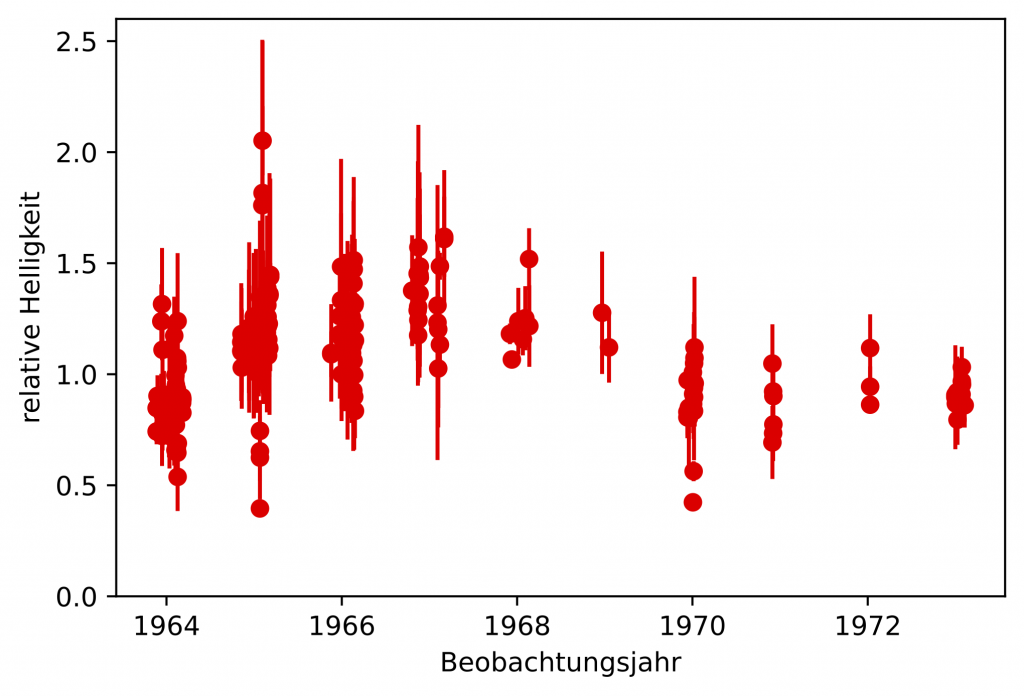German observatories host a heritage of astronomical observations stored on historical photographic plates that show the starry sky (see Fig. 1). Together with the Leibniz Institute for Astrophysics Potsdam and the Universities of Hamburg and Tartu (Estonia), scientists at the Dr. Remeis-Sternwarte have digitised the astronomical images and published them online – after ten years, the project has now been successfully completed thanks to the financial support of the German Research Foundation (DFG).
Even though the oldest images are “only” 129 years old – a truly tiny moment compared to the standards otherwise applied in astronomy – they hold scientific treasures. For it is only with such images that today’s astronomers can study how their brightness changes over several decades at once. In this way, new research questions can be answered and millions and millions of stars can be observed more precisely and objectively.
In several steps since 2012, the research team has digitised the photographs from the archives of the partner institutes from the years 1893 to 1998 in the APPLAUSE database – short for Archives of Photographic Plates for Astronomical USE – and recorded them in a catalogue with details about the photograph, such as date, celestial section and location. In addition, the research network developed software that uses artificial intelligence to eliminate artefacts on the plates such as scratches or dust and to calibrate the images for quantitative research. Scientists worldwide now have 4.5 billion measurements of light sources at their disposal for their research.

A total of over 94,000 photographic plates digitised
A significant proportion of the total of 94,090 photographic plates recorded are the approximately 40,000 photographs taken by the Dr. Karl-Remeis Observatory Bamberg. This is because they include photographs taken by Franconian researchers at observatories in the southern hemisphere between 1963 and 1976. These monitored the southern sky – unique
worldwide, as no other astronomical project surveyed it during this period. In addition, the research network developed software that uses artificial intelligence to eliminate errors on the plates such as scratches or dust and to calibrate the images, making them scientifically comparable. Scientists worldwide now have 4.5 billion measurements of celestial light sources at their disposal for their research.
But that’s not all: thanks to a scientific conference in Bamberg, other observatories became aware of the project. For example, the Thüringer Landessternwarte Tautenburg. It hosts the archive of the Karl Schwarzschild Observatory – the former observatory of the Academy of Sciences of the GDR – from the years 1960 to 1998 and made it available to the research network. Or the astronomical observatory of the Vatican State in Castel Gandolfo, whose scientists also came forward to have their archives entered into the database and thus opened it up to the worldwide research community.
New insights thanks to long-term sky patrol

But what insights can still be gained from the historical photographic plates today? With its surveys of the northern and southern skies in the last century, the Bamberg observatory aimed to examine stars whose brightness varies with time. For some objects, their physical composition is not known, i.e. exactly which gases they are made of. The star “HD49798” is a particularly interesting example. Its unsteady light variations were recorded on the Bamberg photographic plates in the 1960s and early 1970s, but could only be evaluated just now. They show that the star brightened in 1964/65 and then dimmed again until 1974 (see Fig. 2). In addition, there were rapid changes in light within a few days. In 1999, satellite measurements finally revealed that the star was emitting X-rays. Today, the assumption is that it comes from an invisible, very compact companion, possibly a neutron star. The long-term variations in brightness were previously unknown because no sequence of measurements existed over such a long period – ten years. The historical data from the photographic plates therefore provide important clues for astronomy, which will have to be evaluated by researchers in the coming years. Actually, the star duo is still unique, because no other constellation of this type has been observed so far.
Access to the published data:
https://www.plate-archive.org/
See also:
https://idw-online.de/de/news797759
https://www.uni-hamburg.de/newsroom/presse/2022/pm38.html
https://www.aip.de/de/news/digitization-project-photographic-plates-completed/
For more information contact:
Ulrich Heber
Ulrich.Heber@sternwarte.uni-erlangen.de
+49 9131 85-81014




